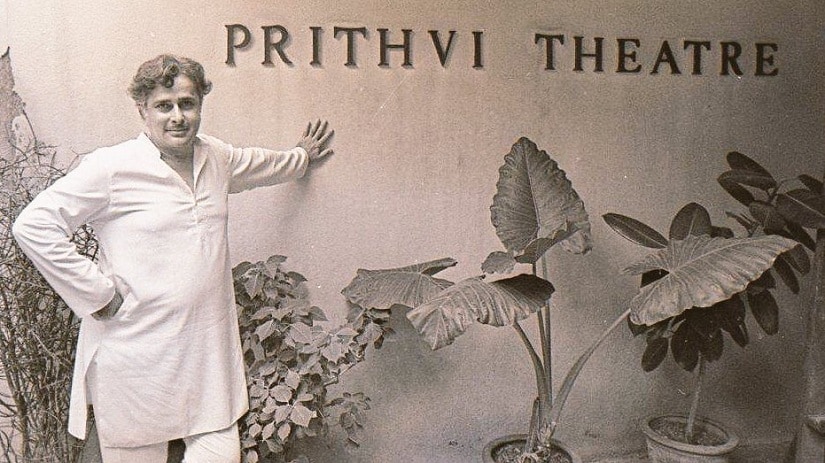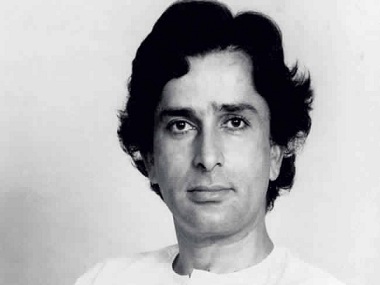Editor’s note: Veteran actor Shashi Kapoor has passed away in Mumbai at the age of 79. This is an extract from the book The Prithviwallas_, presented by Shashi Kapoor and written by Deepa Gahlot, reproduced with permission from publishers Roli Books._ ** The 10-year lease on the two plots in Juhu expired in 1972—the year Prithviraj passed away. In 1974 Shashi Kapoor bought the two plots and set up the Shri Prithviraj Kapoor Memorial Trust. In a letter to her sister, Felicity Kendal, in London, Jennifer Kapoor wrote, ‘Shashi is mad, he wants to build a theatre.’ Later, in an interview, Jennifer said: ‘Back in 1962, when the shed was constructed, the idea was to use it for rehearsals and even performances. But it was extremely badly designed. An L-shaped auditorium was hardly the best option for rehearsals, let alone performances.’ Having acquired the plots, Shashi Kapoor started looking around to raise some funds for the trust. After films like Deewar and Trishul, his film career was flourishing and he did not mind putting in some money of his own into building Prithvi Theatre. Many of his film industry friends got together as well to raise funds. This may well have started the trend of star shows that are such a rage today. [caption id=“attachment_4243483” align=“alignnone” width=“825”]  Shashi Kapoor. Image from Twitter: @FilmHistoryPic[/caption] ‘An organization in Siliguri was willing to donate a little bit of money to the trust, if I could get hold of some stars for a show there,’ recalls Shashi Kapoor. ‘Those were the days when stars came together for a cause, not for money. Amongst others, Amitabh Bachchan, Rekha, Daboo (Randhir Kapoor), Shekhar Kapur, Shabana Azmi, Mohammad Rafi, Hemant Kumar, Sulakshana Pandit, agreed to participate. The show went on for two days—it was a musical show, what one called a “star nite”. Over 18,000 people flocked to see the stars—such a thing had never happened before in Siliguri!’ Mohammad Rafi, Hemant Kumar and Krishna (actress Rani Mukherji’s mother) performed on the first day and were scheduled to leave the next day by the noon flight. Sulakshana Pandit was to arrive in the morning to perform on the second day. For some reason Sulakshana missed her flight. Everyone panicked. If a solution was not found quickly, perhaps the show would have to be cancelled. Shashi Kapoor’s secretary Shaktilal Vaid, begged Mohammad Rafi to stay back. The singer graciously agreed and saved the day. This was one of the earliest occasions when Amitabh Bachchan sang and danced, and interacted with the audience. He performed Mere angne mein tumhara kya kam hai with Rekha—the folk song was later used in the film Laawaris and became a chartbuster. To date this song remains a favourite with Amitabh Bachchan for his stage shows. ‘There were two other similar events but not for Prithvi Theatre. One was a function in Pune to promote small savings for which Amitabh, Zeenat and I had gone. The other was a cricket match in Calcutta—Sanjeev Kumar, Vinod Khanna and Randhir Kapoor had also come along,’ says Shashi Kapoor nostalgically. ‘Amitabh was very negative about the whole thing, he kept saying no one will come, it will be a flop. We were staying at Grand Hotel, and from his suite you could see Eden Garden at a distance. Early in the morning at 6, he knocked on my door. It was a misty Calcutta morning. We had tea and again he grumbled that the event would be a washout. After about an hour, I went to the balcony and saw people coming into the stadium in thousands, like little ants. I called him to the balcony. Unable to believe his eyes, he said, “Are you sure they are coming for the match?” I said, “Of course!” — ‘That day, we played to a packed stadium of forty to fifty thousand people.’ ** Those were the days; in the mid to late ’70s, when Shashi Kapoor had started a new phase of his career—playing ‘parallel hero’, and doing multiple shifts. Raj Kapoor was planning Satyam Shivam Sundaram (1977) and many leading men wanted to work with the great showman. Raj Kapoor, however, wanted Shashi to play the lead. It was one of the busiest periods of Shashi’s career, but even so he told Shaktilal Vaid to take a new diary, put it down in front of Rajji and let him take as many dates as he wanted. The film was meant to have been a quickie, to be completed in three months’ flat. ‘Shakti came back in tears. Rajji had taken all the dates already allotted to other producers. He also insisted that on the days I was to shoot with him, I wouldn’t shoot with anyone else. To accommodate Rajji, I had to work round the clock, doing four to five shifts a day, and sleeping in the car. Rajji promptly nicknamed me “taxi” — a sobriquet that was immediately picked up by the press.’ Shashi was seldom around when his dream theatre was being built. He was away for long spells during the first few years of its growth, because of his grinding work schedule. People thought it strange that he should be investing a large sum of money in a theatre. At that time, there was really no professional Hindi theatre in Mumbai. The Indian People’s Theatre Association (IPTA) was fairly active performing social plays; Satyadev Dubey was doing experimental work in Chhabildas Hall; sporadic amateur theatre activities were organized in schools and during religious functions. Sceptics said nobody would come to Shashi’s theatre because it was located in a residential area in suburban Juhu. In those days it was not easy to commute to Juhu. Before the film stars started moving in, Juhu Beach was just a picnic spot even for the people of Mumbai. Shashi Kapoor recalls, ‘The government did not know how to handle something like this. They had never given permission for a public building which was not quite public — in the sense that it was a private theatre. We had to bully people for permissions. My cousin, Vicky Kapoor, who was a lawyer, helped us through the legal tussles.’
When Shashi Kapoor had first come up with the idea of setting up a theatre, the then governor, Ali Yavar Jung, had offered him land in the Bandra Reclamation Area (where the Rang Sharda Hotel and auditorium now stand). Architect Ved Segan had designed actress Raakhee’s house, which Shashi and Jennifer had liked very much. So they invited him to design the interiors of Shashi’s film production company, Film-valas, in Worli, and subsequently, Prithhvi Theatre.
Says Ved, ‘The original plan was to demolish the existing structure used for storage, plus a portion built for rehearsals, then build a basement, workshop, cafeteria, and a 200-capacity theatre as a stop-gap measure till the Bandra land was allotted. Ali Yavar Jung proposed a committee be set up to study the proposal. Then we decided not to have a third party involved in the project, and to do it the way we wanted to. Jennifer also thought that once the government came into the picture, the project would take much longer to get off the ground.’ ‘Meanwhile, I suggested that we change the roof of the existing structure in Juhu, forego the idea of demolishing the walls, put up a stage, and see people’s reaction. Let people use it and see how it goes. It would cost about a lakh. Jennifer liked the idea and that’s how we started restructuring the building.’ Jennifer, who was never happy with the earlier design, was quoted as having said, ‘Even as a store, the building was a failure. After Papaji died most of the costumes, some quite elaborate, and the props, had to be thrown away—the monsoons and the rats had reduced them to a useless heap. Shashi declared that one day he would build a theatre without a screen or projector, and which would be used only for live drama. After the Shri Prithviraj Kapoor Memorial Trust was set up, Prithivi Jhopda was partly renovated and rebuilt. There were many ideas for the existing shed—it could be redesigned as a theatre school, or a house for old actors, or perhaps a housing complex with a theatre, a library, a dubbing studio— but finally, we decided to simply cover the old structure with a new roof, remove all the inside walls and create a space for performances. This was a simple and cost-effective solution.’ ‘We were not doing all this just for Hindi theatre,’ says Shashi. ‘Jennifer and I just wanted to have a professional theatre. So we built the theatre in such a way that it would attract and encourage people to get involved with theatre. We worked on the basic dhancha (framework) of the theatre together, and decided to see what we could do with it. Thereafter I was not really involved in the actual making of the theatre. I just looked after the finances, so the entire credit of translating Papaji’s dream into reality goes to Jennifer and Ved Segan. The understanding between Jennifer and me was that while it was my idea to build the theatre, it was to be her baby. ’ ‘“Look after it,” I told her. “You will have to create it, nurse it.” At times, she would get annoyed and say that I had thrust this thing on her. But I think eventually she was quite happy. People said it was an ego trip to have a theatre—who knows, perhaps they were right. Be that as it may, I am proud that we were able to build the theatre in spite of very little money coming in from other sources, like the star shows, or a few of my father’s contemporaries and friend’s like actor Mubarak Merchant. Thanks to my films, I was able to put in most of the money myself. I’m just glad that I could afford to fulfil my father’s dream.’


)



